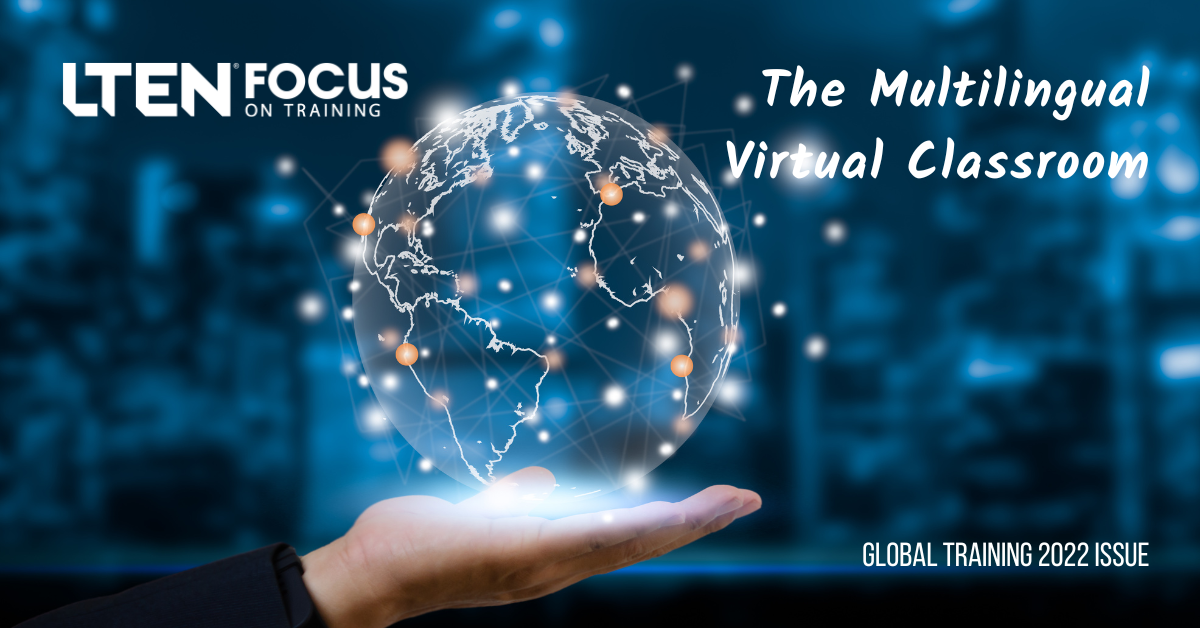
Virtual Training – Cindy Huggett, CPTD
How to create a better learning experience for everyone
A key benefit of virtual training is the ability to bring together a dispersed audience for learning. Virtual classrooms aren’t constrained by time zones or geographical boundaries. The doors are open to anyone who needs the training, regardless of time or location.
The exception is for those participants who don’t speak the same language.
Language barriers typically prevent some potential participants from joining virtual classes. Non-native speakers miss out on learning opportunities when they can’t participate in the conversation. To overcome this challenge, organizations have either needed to provide learning programs in multiple languages or share the training content in some other way.
However, the tide is turning, and what was once an insurmountable challenge is now open for opportunity.
Closing the Gap
Many virtual classroom platforms have added features to help with multilingual communication during an online class. Some of these built-in tools allow for real-time translation so that participants can listen and contribute using their native tongue.
Other tools simply assist those who would benefit from extra support. In addition, skilled facilitators can use techniques to include everyone in the class without hesitation for language differences.
Here are some ways to create a better learning experience when multiple languages are represented in a virtual class:
Enable Closed Captioning
Closed captioning technology has been in use for decades, allowing short text to display on screen in sync with spoken words. Not only does it help with accessibility issues, but it is also a useful feature in the multilingual virtual classroom. Participants can both see and hear the conversation in English (or whatever main language is used). When an unfamiliar word is spoken, or a speaker talks fast, the captions can be a helpful tool for comprehension.
Use Language Translation Tools
Virtual platforms use one of two methods for language translation: translated closed captioning or live transcription. With the first, translated captioning, the system can automatically translate and display the onscreen text in multiple languages. Participants choose which language they want to see.
With simultaneous translation, a separate audio channel is created for designated interpreters who actively translate in real time. Again, participants choose which language channel they wish to use during the virtual class. Both techniques open the door for easier bilingual communication.
Create Bilingual Slides
In my own virtual classes for global audiences, I have focused on one specific language for translated materials. It gets displayed on my slides next to the English words, so that both languages are
represented. For example, on a slide with group activity instructions, the directions are written in both English and Mandarin. This technique works best on slides with minimal text (which is a good practice anyway).
Share Materials in Advance
If the training content has any technical or potentially unfamiliar words, then share materials and handouts well in advance of the virtual class. This extra time allows participants to review the information at their own pace, looking up any confusing words or phrases in their native language. This technique helps level the playing field for everyone.
Pace the Program Accordingly
A successful multilingual virtual class needs extra time for communication. Interpreters benefit from an extra moment to translate. Participants benefit from a few additional seconds to process their thoughts. And everyone benefits from a pace that allows for good conversation and dialogue among all.
Conclusion
While the challenges of delivering virtual training to a multilingual audience may seem daunting, the benefits far outweigh the drawbacks. The diversity of participants with different backgrounds and experiences can create a deeper learning experience for everyone.
Facilitators can skillfully involve everyone, regardless of location or language. The recent advancements in language translation technology make this possible, and it will only get better with time.
Cindy Huggett, CPTD, is a consultant whose books include Virtual Training Tools and Templates and The Virtual Training Guidebook. Email her at cindy@cindyhuggett.com.









